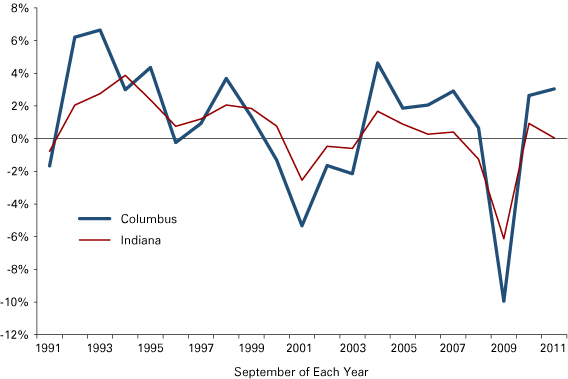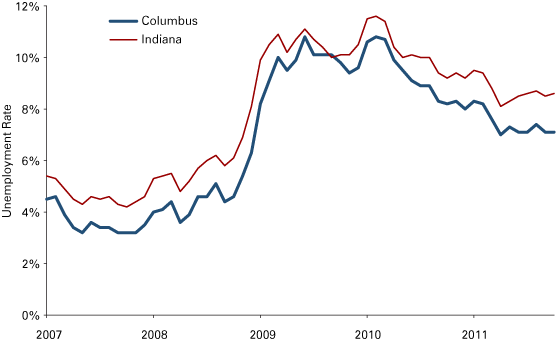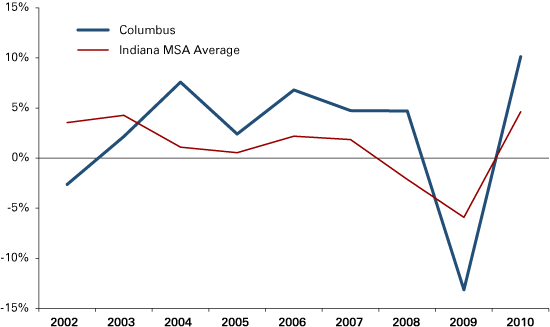Columbus Forecast 2012
MBA Director and Senior Lecturer in Finance, IU Division of Business, Indiana University–Purdue University Columbus
Last year, we described the Columbus and Bartholomew County area economy as having the feel of something in waiting—something just off to the side waiting for more economic fuel and thrust. It looked like growth in 2011 would be slow, but probably ahead of the state. Job growth would also be slow, resulting in an unsatisfyingly slow fall in unemployment rates—but that would also probably improve more quickly than the state.
That’s about how 2011 has turned out. GDP and personal income growth here has been faster than in the state overall. Employment growth has been higher. And unemployment has fallen quicker.
This is unusual compared to the previous two recessions when Columbus recovered more slowly than the state. In large part, that was due to the proportion of the employment base here connected to manufacturing, which once hovered around 35 percent. Manufacturers have always been cautious in ramping employment back up.
Outlook
Within the context of slower-than-desired overall economic growth in Indiana and nationwide, the outlook for Columbus is pretty good. There are several factors influencing this.
First, the numbers look good. Jobs clipped up 7.6 percent since the start of 2010 in Columbus compared to just under 2 percent for the state (see Figure 1). Columbus unemployment dropped more than 3 percentage points to reach 7.1 percent in October 2011 relative to 10.6 percent in January 2010. That compares to a current rate of 8.6 percent in Indiana, down from 11.5 percent in January 2010 (see Figure 2). In fact, no other metropolitan area in Indiana has an unemployment rate as low as Columbus.
Figure 1: Annual Change in Employment, 1991 to 2011

Note: Data are not seasonally adjusted
Source: IBRC, using Bureau of Labor Statistics data
Figure 2: Monthly Unemployment Rates, January 2007 to October 2011

Source: IBRC, using Bureau of Labor Statistics data
GDP data for 2010 showed the Columbus economy growing faster than most other MSAs in the country (see Figure 3). This was due in part to an especially low base established in 2009. And while the data release comes with a considerable time lag, the growth nevertheless resonates with what we are seeing on the ground.
Figure 3: Columbus Annual Real GDP Growth vs. Average of Indiana MSAs, 2002 to 2010

Source: IBRC, using Bureau of Labor Statistics data
Personal income has climbed too. According to models from the Kelley School of Business Center for Econometric Model Research, personal income growth for Columbus will outpace all but the Indianapolis and Elkhart-Goshen MSAs in 2011 and 2012. Columbus growth is expected to be 3 percent in 2012 compared to about 2.6 percent in Indiana.
A second factor influencing a more optimistic 2012 (again, within the context of the overall economy’s continued slow recovery) is Columbus’ increasing integration with a global economy. As the United States suffered through its severe financial asset deflation recession in 2007–2009, economic activity continued at a healthy pace elsewhere in the world. China, India and Brazil are the usual suspects, and their growing economies helped sustain supply chains that in 2011 look much more like worldwide supply webs. As a result, plants and supporting services in Columbus (and throughout much of Indiana, too) are humming right along even as the U.S. economy continues its slow recovery.
Much has been made of this with respect to Cummins, a global manufacturer now with more than 60 percent of its revenues coming from economic activity outside the United States. But Columbus and the region benefit from dozens of companies stitched into this global manufacturing web. This includes Honda’s operations in nearby Greensburg, which is ramping up to a second shift with 1,000 new hires.
Third, the ground-level view in Columbus is noticeably improving. Employment still is about 2,600 jobs below the peak in December 2007 (the official start of the most recent recession). Already announced new positions, however, nearly match that figure (when including Honda). Combined, NTN, LHP, Sunright and NuSun have announced over 450 new jobs on the horizon. LHP, a maker of embedded systems related to the automobile industry, is investing in a new headquarters facility in 2012 and expanding professional jobs by 200.
Cummins expects to expand by an additional 950 professional positions and construct yet another new office building in downtown Columbus.
These new positions support growth in related employment and services as well. The Columbus Economic Development Board estimates area manufacturing-related jobs to have a multiplier of 1.74.
Smart Decisions
Finally, a fourth factor influencing better economic performance in 2012 is the long series of economic development strategies put in place by local officials and leaders over the past 15 years. The city and surrounding area are reaping benefits from many smart decisions. Cummins is still here in part because of local investments in education, downtown development and the kinds of cultural enhancements that make it feasible to bring top-notch engineers and managers from throughout the world to a small Midwestern community.
Things are being built in downtown Columbus: two new banks, two new office buildings, the reconstructed community center, new apartments and the parking facilities to support all of these. It isn’t quite the crane-laced skyline of Shanghai, but the activity here is in stark contrast to other Midwestern communities where new commercial construction is scarce (and long-empty buildings are common).
Nothing in the outlook suggests Columbus’ economy is immune to macro issues related to the U.S. economy overall. A second recession seems unlikely, but it would obviously affect local employment and income negatively.
The total economic package now available in Columbus—a globalized manufacturing base along with public and private leadership committed to creating and sustaining a world-class community—is helping the area recover from a very bad recession in pretty good shape.
Also in this Issue…
- Outlook for 2012
- International Outlook for 2012
- U.S. Outlook for 2012
- Financial Outlook for 2012
- Housing Market Outlook for 2012
- Indiana's Outlook for 2012
- Indiana's Agricultural Outlook for 2012
- Anderson Forecast 2012
- Bloomington Forecast 2012
- Columbus Forecast 2012
- Evansville Forecast 2012
- Fort Wayne Forecast 2012
- Gary Forecast 2012
- Indianapolis-Carmel Forecast 2012
- Kokomo Forecast 2012
- Lafayette Forecast 2012
- Louisville Forecast 2012
- Muncie Forecast 2012
- Richmond Forecast 2012
- South Bend and Elkhart Area Forecast 2012
- Terre Haute Forecast 2012




